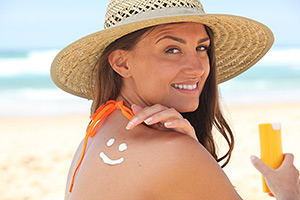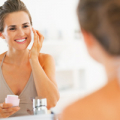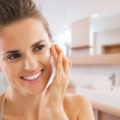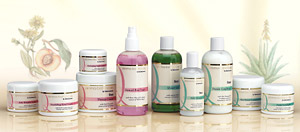How To Avoid Sun Damaged Skin
 There’s no doubt that enjoying the sunshine is one of the best things about summer wherever you live in the world.
There’s no doubt that enjoying the sunshine is one of the best things about summer wherever you live in the world.
Especially after all the time we’ve endured stuck indoors during the long lockdowns, finally being able to get out in the sun is a true blessing.
But there can be a hefty price to pay if you don’t respect the awesome power of the sun.
You must protect your skin at all times from overexposure or you risk baking it dry and developing wrinkles, or much worse if you seriously overdo things on a regular basis.
Excessive exposure to sunlight can cause irreparable damage to the skin and is now considered the leading cause of skin cancer all around the world, with 1,000,000 new cases expected to be diagnosed this year in America alone. This figure is astonishing, and we should all take heed of it.
Tanning produces deep skin wrinkles, accelerates aging of the skin, makes the skin texture leathery, and can cause unsightly discoloration such as ‘age spots’. Put all of this together and it’s easy to see why sun damaged skin never looks attractive. Alternatively, avoiding too much sun exposure will help keep your skin tone more even, your wrinkles minimal and your skin texture soft.
So let me ask you; are you as careful to protect your skin from sun damage as you should be? Do you wear sunscreen every time you go outside for prolonged periods, or do you think you’re somehow safe or immune from the risks of skin cancer or sun damaged skin?
The risks of tanning
Everybody is now aware of the dangers of skin cancer resulting from overexposure to the sun, and whilst people who rarely burn are less likely to contract skin cancer than people who burn easily, everyone is still at risk. This also includes people who have no family history of skin cancer.
Surprisingly, a recent study reported in the British Medical Journal found that people who use sunscreens the most are more likely to get skin cancer than those who never use it. This is because they mistakenly believe that they can stay in the sun for longer, especially when the sun is at its hottest.
Our collective knowledge about the causes of skin cancer risks is constantly changing, for example; dermatologists used to condone minimal use of high-pressure tanning beds (which use UVA rays almost exclusively, with very little of the UVB rays) for those who tan easily without burning. The tan from these beds was originally thought to be safe, but now dermatologists are finding that UVA rays cause deeper tissue forms of skin cancer, which are more difficult to detect and treat.
Until more is learned about the causes and risks of tanning it would be wise to avoid overexposure and protect your skin by using a sunscreen and limiting the amount of time you spend unprotected in the sun. We still want to enjoy the benefits that the healing rays can bring because the golden glow of a healthy looking tan always makes us feel better, we just need to look after our skin and sunbathe more safely to prevent sun damaged skin.
Protect your skin from sun damage
Broad-spectrum sunscreens provide excellent protection from natural sunlight exposure, and even if you’re not going to be outside in the sun for long it’s a good idea to put some on exposed skin while dressing in the morning, particularly in the summer time. If you’re concerned about potentially dangerous chemicals that are used in sunscreen, such as Para-amino benzoic acid (PABA), choose those that use safer ingredients such as Zinc oxide or Titanium dioxide.
Take a look next time you’re shopping and you’ll find sun protection products that are waterproof and sweat proof, some are designed especially for infants and others are specially-formulated for athletes. Sun protection products are available as creams, lotions, oils, tanners and bronzers.
But what’s with those numbers? The sun protection factor (SPF) ranges from a low of 2 to a high of 50 or even higher. Most of us understand that the SPF has something to do with providing protection from the sun’s damaging ultraviolet rays. But beyond that, for many people the number is shrouded in mystery. What does SPF mean?
Sun protection factor explained
The SPF indicates the time a person with sunscreen applied can be exposed to sunlight before burning their skin, compared to the time a person without sunscreen can be exposed. This assumes constant solar intensity over the time period. On any day, someone who would burn after 12 minutes in the sun would expect to burn after 120 minutes if protected by a sunscreen with SPF 10.
When choosing, remember that a higher SPF does not offer more protection – it offers longer protection – but only up to a certain point. If you don’t use these products correctly they will not protect you from sun damaged skin. In practice, the protection from a particular sunscreen depends on factors such as:-
- The skin type of the user, for example dark or light skinned.
- The amount of sunscreen applied and frequency of re-application.
- Amount of sunscreen the skin has actually absorbed.
- The activities in which you engage. Both water and sweat diminish the product’s effectiveness, that’s why it’s extremely important to reapply sun protection frequently after swimming.
Besides reapplying, for maximum effectiveness the first application should take place approximately 20 minutes prior to going out into the sun. Doing so allows sufficient time for the product to fully absorb into the skin where it can do its job. It also ensures that you’ll be protected the moment you step outside.
One final but very important point; you need to know that no matter what SPF you use, it only applies to the suns UVB rays. There is no SPF equivalent for UVA rays, so you should never rely solely on the SPF on products as a guide to how much time you can spend in the sun safely. Don’t forget to use your common-sense as well as your sunscreen.
Copyright © Quinessence Aromatherapy Ltd 2021. Written by Sue Charles

































